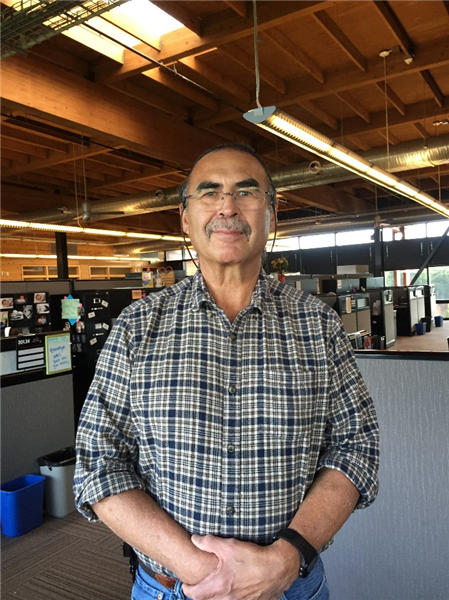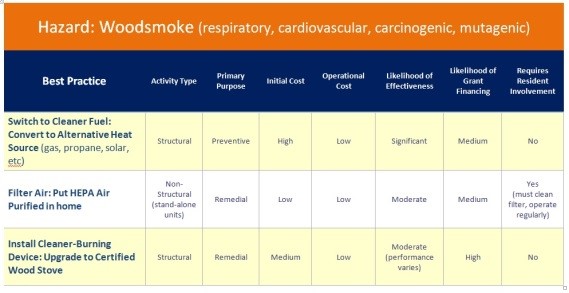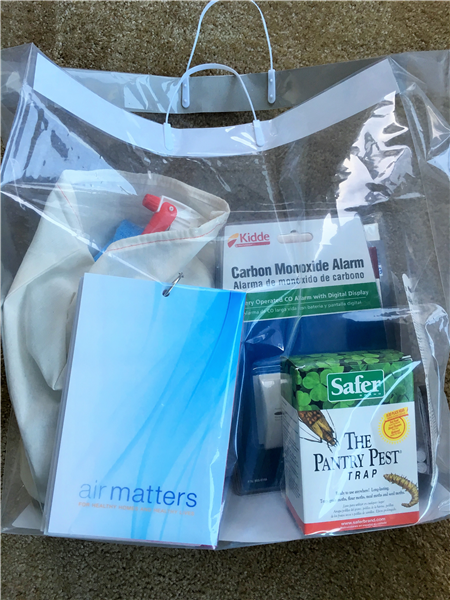 |
Indoor Air Quality Programs - |
|
Over the past few years we have seen Indoor Air Quality (IAQ) practices starting to become regularly integrated into tribal programs and departments. As IAQ programs grow, it’s important that we acknowledge the great work that is being done in this area. The matter of a healthy home is important to all persons involved and by highlighting various IAQ programs we can learn and grow from the great work that is being done in the field.
Comanche Tribe - Chad Tahchawwickah
Chad Tahchawwickah with Comanche tribe provides free Indoor air assessments, to their tribal members, and uses the data to create a comprehensive IAQ report for the resident. The program’s success continues to grow and we applaud the work of Chad and his team!
Red Cliff Tribe - Ernie Grooms
Ernie Grooms with the Red Cliff Tribe has been working with Red Cliff’s health and maintenance specialists to provide an in-depth IAQ assessment for his residents. Complete with IAQ remediation recommendations, health and safety concerns and maintenance suggestions Ernie’s checklist approach proves and all-inclusive report for each resident.
Tulalip Tribe - Your Air Matters Program
Dean Henry with the Tulalip Tribe is a man with a mission. As the Health and Safety manager of Tulalip he has made it his personal mission to remediate Indoor Air Quality issues within Tualip’s residential housing. In collaboration with THHN’s your airmatters program, Dean and THHN provided Tulalip members with free tool kits which aimed to educate residents on IAQ issues and provide IAQ assessments for tribal residents.
|
 |
| Comanche Tribe - Chad Tahchawwickah |
|
Chad Tahchawwickah
Indoor Air Specialist
Comanche Nation Office of Environmental Programs
Tell us about your Healthy Home program or activity:
The Comanche Nation Office of Environmental Programs, Indoor Air Quality Program was established around 1998, we are located north of Lawton and Fort Sill Oklahoma and just east of Medicine Park
Oklahoma. We service Comanche County and seven bordering counties. Since we are not located on a Reservation we are able to serve Comanche Nation Tribal Members as long as they reside in
Our tribal jurisdiction or any county we serve. Our Indoor Air Quality Division is growing in leaps and bounds by providing our tribal members with a free Indoor Air Quality Assessment which consist
Of inspections for mold, dust, cleaning agents, carpets, room deodorizers, pets and so much more. We gather as much information about the home as we can, ie; when it was built, what type of foundation
Or roof it has and if there has been any floods or water damages at any time in the past. Also we get a layout of the area for several miles to survey what might cause indoor air pollutions. Farms, oil rigs, Industrial Businesses, airports, busy highways or roads. We compile the data and create a Simple to Understand Report with pictures and recommendations to improve indoor air quality.
What were the outcomes you wanted to achieve? What came out of it that you didn’t expect? – Would you do anything differently to achieve results?
If I was able to educate our tribal members, especially those with children and our elders and they implemented the recommendations, then my achievements were met.
What came out of it that I did not expect Was IAQ was not a high priority in our tribal member’s homes. I even have to admit that I never thought about it before my path brought me to where I am today. I believe for our program to achieve its highest results is to do follow ups with our tribal members that have had an IAQ Assessment done. To implement even just some of the recommendations would make me feel better about their IAQ.
What are the key lessons learned that other tribes should know before they adopt a program like this?
Humble yourself. Consider yourself a servant to your people. To serve and to protect them and to educate them to the best of your abilities concerning IAQ. Also attend as many trainings as you can, then when you return home, attempt to implement something you may have learned. Add to your IAQ Assessment or take something away. Each training, webinar and home assessment is a building block to make your IAQ Program a success. When you become a necessity to your people, your worth is more valuable. Mistakes will be made, missing reports, deleted pictures, but learn and go on!
What inspires you to do this kind of work? How did you get into this field?
I am Comanche and very proud of it. I grew up in our jurisdiction area and attended many ceremonies, powwows and activities with other tribal members and I love them. I love my People. I am inspired by
Their well-being. If I can make their life a little bit easier and enjoy the comforts of their home then it’s all worth it in the end. Like many people, I do many things and am a man of many trades, I travel throughout Indian Country MC’n Powwows, performing Stand Up Comedy, singing with our drum group Wild Band of Comanches and providing Suicide and Meth Prevention. My late older brother Keith Yackeyonny was the WIA Director and got me a job at Comanche Nation Office of Environmental Programs as a laborer. After a few short weeks the chance to move up showed itself and it has been history ever since. IAQ has opened many doors and has brought many people into my life.
Chad's Contact information:
Chad Tahchawwickah - Indoor Air Specialist
Comanche Nation Office of Environmental Programs
chadt@ComancheNation.com
|
 |
| Red Cliff Tribe - Earnie Grooms |
|
Ernie Grooms
Red Cliff Air Quality Tech
I utilize a “checklist” I’ve reconfigured which details my readings from initial entry into the home, then proceed to document each room of the home.
I then take all this information and provide the home owner with a copy listing all the findings in each room of home (with thermal imaging pics), and comment s on how to remediate many of the problems they are having. This gives the home owner a total breakdown of their home to utilize for information when using a contractor or housing authority maintenance for repairs/remediation.
I also utilize our Health Centers “Health Specialist” when conducting IAQ assessments (especially when children are in the home/elderly), which gives an even more detailed look into what a home needs to maintain a safer environment, with tips on chemical storage (cleaning supplies/medications), cleanliness, and remediation suggestions for the home owner. Many times, our Health Specialist calls me to assist in conducting assessments.
In addition, when conducting assessments on “Tribal Housing Units”, I schedule a maintenance worker to accompany the Health Specialist and I to cover structural/appliance issues utilizing their checklist (thus providing three findings reports for the home owner and Housing Authority).
Ernie’s Checklist:
1) Sample for Carbon Dioxide (ppm)
Carbon Monoxide (ppm)
Particulate Matter (PM at 0.5 microns)
Relative Humidity (%)
Ambient Temp (F)
Wood Moisture (%)
Thermal Imaging (pictures to show areas of concern within exterior walls/ceiling)
2) List window types (energy efficiency, water stains, mold/mildew) Most homes with mold/mildew found have used blankets to cover windows holding in moisture.
Door Threshold seal (good or need replacing)
Type of flooring
Clothes dryer vented to outside
3) Kitchen items (stove fume hood, CO detector, fire alarms, etc.)
4) Type of heating units (electric, natural gas, wood heat)
5) Air exchanger (if any)
6) Wall covering (dry wall, paneling, wood plank, etc.)
7) Outdoor area to include:
a) Type of siding
b) Roof (steel or shingle)
c) Landscaping (noting if water sheds away from home or to home)
d) Exterior door condition
I am beginning to attend the Housing Board meetings in hopes of educating the “powers that be” in better ways to upgrade their units when funding is available.
Ernie's Contact Information:
Ernie Grooms - Red Cliff Air Quality Tech
Phone: 715-779-3650
|
 |
| Dean Henry - Tulalip Tribes |
|
Dean Henry
Health and Safety Manager
The Air Matters program is a pilot program at the Tulalip Tribes in Washington led by Dean Henry and his Healthy Home Team. The air matters program was established as a means to address indoor air quality utilizing healthy home tool kits, which include tools such as a dust mite pillow case, hygrometer and digital moisture meter. The tool kit serves as a way to educate residents about indoor air quality through low cost tools that are easy to install and use. The tool kits help improve the health of residents by reinforcing behavior change, such as
monitoring relative humidity within the home using the hygrometer, or measuring moisture in drywall or wood using the digital moisture meter. It also helps empower residents seek additional help with larger, structural issues, if necessary. Our program hopes to decrease the burden of asthma and other lung diseases by improving knowledge among tribal members and creating awareness about indoor air quality throughout the entire tribe.
The major goal of the Healthy Homes Team and the Air Matters Program was to educate tribal members about the health impact of indoor air quality, and to create a partnership between our program, the health clinic and housing department. We managed to not only create this partnership, but also start a referral program where the health clinic refers all patients with asthma and other lung diseases to sign up for a home visit and tool kit. Dean, and the Healthy Homes Team have taken tremendous steps in looking for funding and applying for grants. There are a number of partners that are available throughout the region, such as Snohomish County PUD, and the Bonneville Power administration, both of which provide grants for weatherization
work.
Some key lessons tribes should learn prior to adopting this program is to look into all potential funding sources, such as the BIA HIP grant, state Medicaid reimbursement program, or various EPA grants, in order to insure that kits will be funded. It is also really important to meet with different organizations and groups that can be partners with your program in order to reach and serve as many tribal members as possible.
Dean's Contact Information:
Dean Henry - Health and Safety Manager
Email: dhenry@tulaliptribes-nsn.gov
Office: 360-716-4439

|
|
| Looking for Ideas to Protect Your Community from Hazards in the Home? |
|
Take a few minutes to check out our new "Best Practices Catalogue". In the catalogue, you'll find a list of over 30 different activities that a tribe can select from in order to address indoor air quality. It covers most of the major and common hazards....from radon gases to mold to household chemicals. Our goal in creating the catalogue was to provide more than just a list, but to add value by providing a decision-making tool.

The activities in the catalgue all have a scientifically-demonstrated health benefit, but they vary in their effectiveness, intensity and cost. We encourage you to spend some time looking through the activities and if any are of interest to you, please contact us and we can help connect you with potential grant sources and provide technical assistance.
|
 |
|
|
We've rescheduled our Connections call!
Please join us January 28th, 2016 at 11AM PST
We will be hosting a question and answer session about our highlighted Indoor Air Quality Programs.
|
|
|
Is Medicaid a Future Funding Source for Tribal Asthma Home Visits?
Housing-related illnesses, including asthma and childhood lead poisoning, are estimated to cost the nation $53 billion annually. Some states have established Medicaid reimbursement for services delivered in the home environment related to asthma, while many others are actively working to establish or expand reimbursement opportunities for these activities through Medicaid waivers or amendments to State Medicaid plans.
Some tribes are actively engaging in this reform process, as Medicaid often covers asthma expenses associated with hospitalization. Yet Medicaid, if reformed in your state, could also fund trained tribal staff to provide asthma home visits (which
include an indoor air quality assessment). To encourage this potentially very positive development, the Tribal Healthy Homes Network is working in Region X with tribal, state and federal partners to advocate for Medicaid reform.
Along with individual tribes in the region, we are specifically working in Washington State, where a “global waiver” process has opened the door for tribes to request the asthma home visit reimbursements. Please contact us if you’d like more information about current reform activities in your state. THHN can also send your links to our library of current publications on Medicaid reform and asthma home visits.
|
 |
Want more information about the AirMatters ToolKits?
Please contact Krysta Thornton
Email: kthornton@thhnw.org
Phone: 1-800-717-2118 X 4
|
 |
|
or visit our website at www.yourairmatters.org
|
  |
|
|